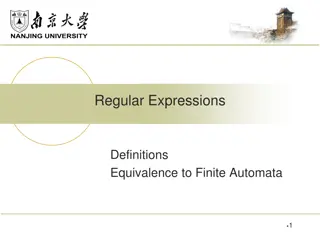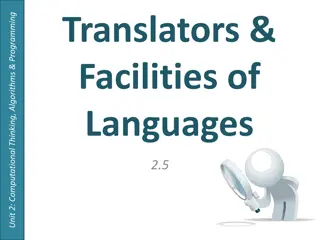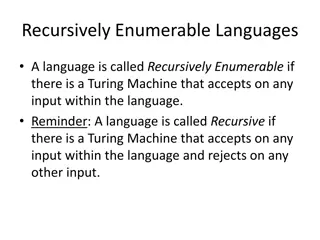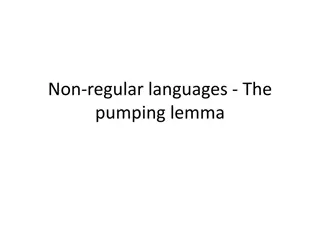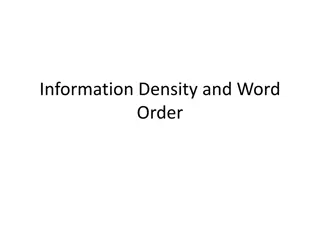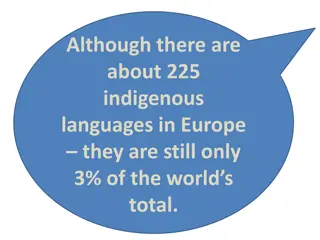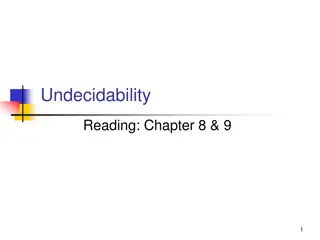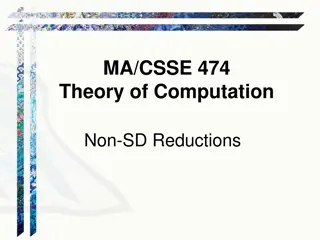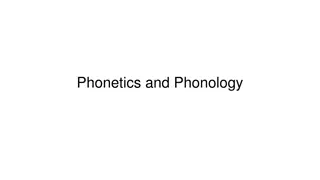Understanding Word Order in Different Languages
Explore the fascinating world of word order in languages. Discover how different languages arrange words in various ways, such as Subject-Verb-Object (SVO), Subject-Object-Verb (SOV), and more. Delve into the diversity of word orders for subjects, objects, and verbs, and uncover how language structures can vary within a single language. Gain insights into why most languages prefer having the subject before the verb, and the subject before the object. Dive deeper into how word order patterns can offer valuable insights into language structures.
Download Presentation

Please find below an Image/Link to download the presentation.
The content on the website is provided AS IS for your information and personal use only. It may not be sold, licensed, or shared on other websites without obtaining consent from the author. Download presentation by click this link. If you encounter any issues during the download, it is possible that the publisher has removed the file from their server.
E N D
Presentation Transcript
Language Awareness for Key Stage 3 14: Word Order 1
Roadmap Today we will look at word order and how languages arrange words in different ways We will see different orders that languages use for subjects, objects and verbs We will look at different word orders for adjectives and adpositions (prepositions/postpositions, e.g. on) We will also look at how word order can vary within a single language and how languages use different word orders We will see how word order patterns can tell us about the structure of language in general 2
Word Order You may remember from our first lesson that different languages have different orders for subject, object and verb 1. Subject Verb Object (SVO): 2. Subject Object Verb (SOV): 3. Verb Subject Object (VSO): 4. Verb Object Subject (VOS): 5. Object Verb Subject (OVS): 6. Object Subject Verb (OSV): I saw them I them saw Saw I them Saw them I Them saw I Them I saw 3
Word Order English (SVO) Cree (N/A) Irish (VSO) Japanese (SOV) Nad b (OSV) Tuvaluan (OVS) Malagasy (VOS) Map adapted from WALS 4
Word Order From the map you can see that some types of languages are much more common than others 488, 35.5% 564, 41.0% 95, 6.9% 189, 13.7% 25, 1.8% 11, 0.8% 4, 0.3% SOV SVO VSO VOS OVS OSV N/A 5
Word Order Most languages show a preference for having the subject before the verb, and having the subject before the object Why do you think this might be? 6
Word Order Most languages show a preference for having the subject before the verb, and having the subject before the object Why do you think this might be? The evidence suggests that these types of language are somehow easier However, we don t yet have enough data to say what makes this easier, or in what way 7
Word Order The order of subjects, objects and verbs is not the only thing that can vary from language to language You may remember that languages have different types of adpositions Some languages have prepositions, which come before the noun Others have postpositions, which come after the noun 7. in Japan 9. Nihon ni 8. from Tokyo 10. Tokyo kara (English) (Japanese) 8
Word Order Likewise, in some languages adjectives come before the noun, while in others they follow it 11.black coffee (English) 12.schwarzer Kaffee (German) 13.kurodesu k h (Japanese) 14.caf noir (French) 15.caife dubh (Irish) 16.coffi du (Welsh) 9
Word Order There are patterns in this variation in word order For example, languages with the verb before the object tend to have prepositions before the noun Languages with the object before the verb are more likely to have nouns followed by postpositions 10
Word Order However, there are exceptions to some of these patterns For example, languages with the verb before the object often place nouns before adjectives, as in Irish However, in English the verb comes before the object, but adjectives come before the noun 11
Word Order Why do these patterns exist at all? They can be seen as different applications of the same general principles For example, verbs have the same sort of role in regard to their objects as prepositions do Verbs and prepositions specify the type of relationship that exists, and the objects specify what the relationship is to 17.A hedge surrounds the garden 18.There is a hedge around the garden 12
Word Order We can say that in relation to their objects, verbs and prepositions are both heads The verb and the object that depends on it form a single unit, the verb phrase, with the verb as the head of the phrase The same is true for prepositions and prepositional phrases The patterns that we see in word order can then be expressed as a single statement In any given language, heads will tend to have the same order with respect to their dependants 13
Word Order Head + Dependant Verb + Object, Preposition + Noun Dependant + Head Object + Verb, Noun + Postposition 14
Activity Some of you may know languages other than the ones we ve discussed here Take some time to make a note of word orders in these languages You can look at subjects/objects/verbs, nouns/adjectives, and nouns/adpositions If a language can have more than one order, try to choose the most basic, ordinary one Afterwards, you can compare notes. What patterns do you see? 15
Word Order So far, when we have talked about word order we have only been looking at a single, basic word order for each language However, many languages allow you to vary this basic word order for different reasons 16
Word Order You may remember that languages in which subjects and objects are clearly marked using case endings can be very flexible about word order For example, in Latin there are six different ways of saying John saw Mary 19.Johannes Mariam vidit 20.Johannes vidit Mariam 21.Vidit Johannes Mariam 22. Vidit Mariam Johannes 23. Mariam vidit Johannes 24. Mariam Johannes vidit 17
Word Order What good are all these different orders? One use for them is to change the emphasis In Latin, the normal order is subject object verb 25.Johannes Mariam vidit John saw Mary By rearranging the sentence, you can focus on different words 26.Mariam Johannes vidit As for Mary, John saw her , It was Mary that John saw , etc. As you can see, changing the emphasis in English often results in a more complex structure 18
Word Order Even in English, you can sometimes add emphasis just by changing the order of words 27.Mary s alright, but John I hate However, examples like this are unusual enough that we can still say the usual order for English is SVO 19
Word Order One very common use for different word orders is to distinguish different types of speech act 28.Mary is so happy. (statement) 29.How happy is Mary? (question) 30.How happy Mary is! (exclamation) 20
Questions Moving the verb before the subject is a very common way of forming questions in Indo-European languages 31.Is Mary happy? (English) 32.Ist Maria froh? (German) 33. Est Maria feliz? (Spanish) However, there are also other ways of forming questions 21
Questions Another way to form questions is by leaving the words in the same order and just using a different tone of voice 34.Mary s happy? In English, this sort of question is often used to echo a previous statement Mary s happy. She s happy? 22
Activity Take some time and try to think of other situations where you might use this sort of question in English Can you come up with a list of rules about when to use which sort of question? 23
Questions Some languages make much more extensive use of questions that leave the words in the same order This is the most common sort of question in informal French 35.Est-elle heureuse? (formal) Is she happy? 36.Elle est heureuse? (informal) She s happy? 24
Questions In other languages, this is the only way of asking questions In Amharic (spoken in Ethiopia), all questions have the same word order as statements 37.Mariyami desitenya nati Mary is happy 38.Mariyami desitenya nati? Is Mary happy? 25
Sentence Structure So far we have only been looking at the order of words But word order is inseparable from other aspects of language For example, word order can have an effect on agreement You may remember from the last lesson that verbs agree with their subjects However, agreement can be affected by word order 26
Sentence Structure In Arabic, subjects can appear before or after the verb 39.L-tullaabu wasaluu The students have arrived 40.Wasala l-tullaabu The students have arrived (literally, Has arrived the students ) When the verb comes first, it no longer agrees with the subject The verb is singular, but the subject is plural 27
Sentence Structure However, this does not happen in most languages that allow multiple word orders 41.Hoi math ta aph konto The students have arrived 42.Aph konto hoi math ta literally, Have arrived the students As you saw earlier, word order has no effect on agreement in Latin either (Greek) 28
Sentence Structure What do these differences mean? Even though we see the same word orders in Arabic and Greek, the similarities are just on the surface There s a sense in which the verb in Arabic is actually in a different place from Greek, even if all you can see on the surface is that they are both before their subjects It almost seems that in Arabic the verb is somewhere where the subject can t reach it 29
Sentence Structure Studying these sorts of similarities and differences between languages can let us see patterns that exist below the surface of language When we look at these things, we are studying syntax Syntax is the system of rules that a language has for combining words into sentences In the next lessons we will see more examples of these patterns 30
Conclusion Today we have seen how different languages have different rules for arranging the words in a sentence We have seen how specific differences that seem arbitrary can be expressed in terms of more general rules We have looked at the use of special word orders for special purposes such as questions We have seen that in some languages word order can affect agreement This is an example of how languages can seem the same on the surface but be different underneath 31


